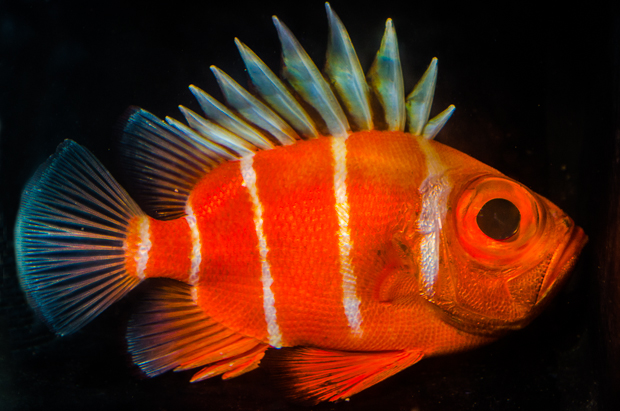The family Priacanthidae, more commonly known as Catalufas and Bigeyes, are strange looking fish that look less out of place with Alice and her wonderland than in the ocean. The family comprises of roughly twenty species, in four genera namely Cookeolus, Heteropriacanthus, Priacanthus and Pristigenys. Of the four, Pristigenys is most often encountered in the aquarium trade, but with the exception of P. alta and P. serrula, are all rare. Pristigenys are large, deep dwelling species most noted for their large circular eyes and deep red basal coloration. The members possess roughly equal number of hard dorsal spines and soft rays, but because of the great exaggeration and size of the spinous portion, they can take up to 70% of the total length.

Of the genus, P. niphonia is arguably the most spectacular, akin to a large eyed experimentally doctored frankenstein version of Paracentropyge boylei (Peppermint Angelfish). The scarlet ground colour is decorated with four to five vertical white stripes, and the mohawk like dorsal spines are coloured in the same hue. The exceedingly rare and deepwater P. meyeri shares a similar template, but is more densely decorated in broken bars. P. niphonia is wide ranging, being found in much of the Western Pacific including Indonesia, Japan, and eastwards to Australia. Adults are more commonly seen in rocky habitats up to a 100m (300ft), but can occasionally be found in shallower waters. Juveniles are known to seek shelter in human trash such as drink cans and empty bottles.

The bigeyes are remarkable for their well, big eyes, and is an adaptation suited for their deep dwelling nature. In environments where light is a scarce commodity, a larger eye with an increased retinal surface area would allow for a higher entry and reception of available light. It will not be surprising as well if the photoreceptor cells within the retina contained a higher concentration of rhodopsin, a biological pigment which enables vision in low-light conditions. In addition, Pristigenys have an added tapetum lucidum situated just behind their retina which allows for even more enhanced night vision. The tapetum lucidum is a membranous layer consisting of iridescent leucophores which reflects visible light back into the retina, increasing the amount of light available to the photoreceptors. The presence of a tapetum lucidum contributes highly to the superior night vision seen in many nocturnal animals and deep sea fish. In terrestrial animals, the tapetum lucidum is what gives an animal its characteristic “eye-shine”, most commonly seen when light is shone directly into the eyes of said animal, such as a “deer in headlights”.

Large eyes and tapetum lucidum aside, Pristigenys is remarkable for having a rather unique ocular morphology that we haven’t noticed before. We’re not ophthalmologists, neither do we know a whole lot about fish eyes, but within the structure appears to be a network of large blood vessels.Blood vessels supplying nutrients and oxygen to ocular structures are usually nestled under the sclera, but interestingly these appear to be free floating or rather suspended within the vitreous humor. Whether this is something that all organisms have, we’re not sure, and if anyone knows a thing or two about fish eyes we would gladly welcome any comments or correction. It is however highly fascinating to stare into the pupil of these fish and see these vessels in a very three dimensional manner. The photo directly above shows the set of vessels within the pupil, and two photos above shows the same structures backlit by the tapetum lucidum.

P. niphonia is a hardy fish and will do well in a large tank with dim lights and heavy rockwork. They will accept most large chunky foods, which includes small living fish, so appropriate tank mates have to be carefully selected. These photos and specimens were photographed in situ at Bali Aquarium, where half a dozen or so individuals are being held post collection. If you like something with a freaky flare that tries very hard but unsuccessfully to be a pretty peppermint angelfish, this is the freak for you.



